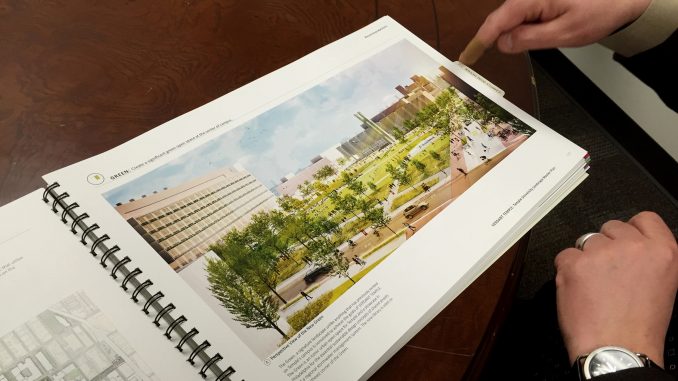
As current and future students picture the state of Main Campus in the next few years, they should expect more green—both in landscape and in practice.
James Templeton, Temple’s director of Architectural Services, said along with the Visualize Temple plans to develop and build new structures, like a new library and centrally located quad, the Verdant Temple plan will incorporate much more foliage and subsequent sustainable practices into daily life.
“There are lots of facets to sustainability,” Templeton said. “And it’s not just about energy, it’s about quality of life. We want livable, workable, healthy environments.”
These projects will range from redevelopment of some buildings and walkways to reconfiguring the entire center of campus to make way for a grassy area that can act as the “heart of campus,” the plan describes. These projects will happen during the next 20 years, Templeton said, but “a lot will be coming in the next five years.”
The official first step in the plan was the renovation of Liacouras Walk last summer to “unify” the walkways on campus and to add some function to the bricks that line the path. Before, rainwater was easily trapped with nowhere to go, Templeton said, but the current design allows for 95 percent of water to be managed, either by re-entering the ground or by being directed to the correct area. Pollet Walk is the next project to tackle, expected to start after this semester has ended and finish before the Fall 2016 semester.
The plan also aims to add green space to “residual spaces”—areas like crosswalks and sidewalks, targeting areas like the stretch between the Temple University Train Station at 11th Street near Berks and Anderson and Gladfelter halls to create “another entrance to campus,” Templeton said.
By following the city’s standards for new buildings, the university will get close to meeting Leadership in Energy and Environmental Design goals which are measured by certified, silver, gold and platinum awards.
Certain buildings like the Architecture Building and Montgomery Garage are silver certified, while Science Education and Research Center has earned a gold certification from the interior and exterior design as well as the rainwater drainage system incorporated into the landscaping.
University officials are continuously looking at ways to reduce Temple’s energy use or find newer, greener energy to supplement its current use, Kathleen Grady, Temple’s director of sustainability said.
“We’re currently trying to balance energy efficiency and green power purchasing,” she added. “If there were more student interest in green power, I believe the university might make it a more pressing matter.”
There are different ways of reducing consumption, either by looking at those more renewable options, or by reducing the institution’s overall demand. Green power reduces the use and strain on the environment right away, but the cost happens every year, she said.
During the next 20 years, Templeton said, the university will look at making environmentally friendly changes like replacing most lights with LED and considering renewable energy options, which could bump the energy efficiency closer to 10 percent, compared to the current 0.01 percent.
Templeton said the university’s location gives “megapoints” toward their goals of being more sustainable; having many options for public transportation like regional rail lines and the bike share program like Indego, keeps the footprint smaller.
Considering renewable energy in combination with the other projects in the works would make the university more competitive with University of Pennsylvania’s 54 percent and Drexel’s 100 percent green power usage, according to the Environmental Protection Agency.
“Sustainability isn’t the driving force of many of these projects,” Templeton said. “But a positive effect of changing regulations and lifestyles.”
Paige Gross can be reached at paige.gross1@temple.edu or on Twitter @By_paigegross.


Go green all the way! Fully support your cause! Thanks for the article!